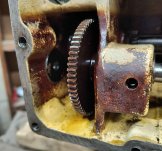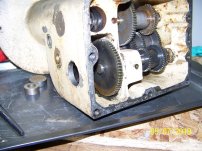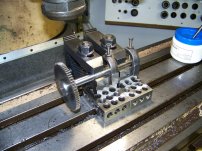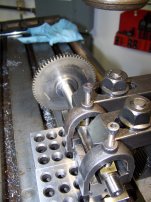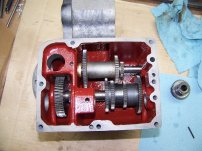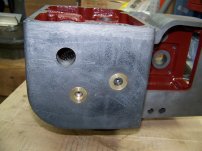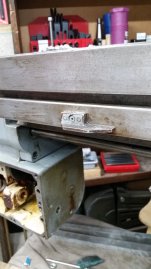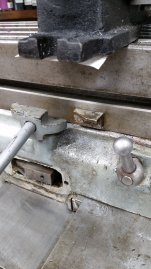I have finally gotten around to re-installing the cross axis power feed on my Toolmaster. Removed the cover, removed some varnish on the 'C'? (lower, front one) shaft that was restricting the gear pack from sliding back and forth, and cleaned it out as best I could. All the gears and shafts -looked- okay (no chipped teeth, no slop) so I reinstalled the box back onto the table with the motor and front cover removed (Motor runs fine, tested separately). I made a test driveshaft so I could operate the gearbox with a cordless drillmotor. That worked fine on the bench, all the shafts/gears appeared to work well, the output gear (the wide brass one) spinning happily. But..., once installed, with the load of the table, the output shaft stopped moving, even with the input being driven. The larger (but thin) gear shown in the pictures is turning, but the shaft it is supposedly keyed to is not. So the key is sheared or not there, right? In trying to figure out how to remove that, my machinist eagle eyes (yeah right) spot an access port of the side of the case! Complete with a hex head socket. What could be easier? I just unscrew that plug, remove a couple of snap rings, slide the shaft out, replace the key, and put it all together!
Yeah, not so much.
Turns out (pun) that hex is part of a -smaller- plug threaded into the big one. So, it came out and the big one did not, and has not. I don't know if it is threaded in there and I need a special tool, or 'just' pressed in, or what.
My questions involve:
1. Is it even reasonable (is there room) that that shaft can come out, I can replace the key, and get it back together, or am I doomed to having to remove the big worm gear driven part.
2. What is the sense of having that hex plug in the middle of the bigger plug?
3. In general how are any of the plugs 'supposed' to be removed.
The manual is of course silent on all this. And frankly, other than the drawings, I find the manual of little use.
I have never used any other mill, so I have no comparison experience, but I really like this machine. I think it is good at dealing with all my newbe mistakes, luckily none of which has broken anything.
Anyway, if anybody has any input on how to get out of this kind of a ditch, I would very much appreciate it.
rgsheehan
Yeah, not so much.
Turns out (pun) that hex is part of a -smaller- plug threaded into the big one. So, it came out and the big one did not, and has not. I don't know if it is threaded in there and I need a special tool, or 'just' pressed in, or what.
My questions involve:
1. Is it even reasonable (is there room) that that shaft can come out, I can replace the key, and get it back together, or am I doomed to having to remove the big worm gear driven part.
2. What is the sense of having that hex plug in the middle of the bigger plug?
3. In general how are any of the plugs 'supposed' to be removed.
The manual is of course silent on all this. And frankly, other than the drawings, I find the manual of little use.
I have never used any other mill, so I have no comparison experience, but I really like this machine. I think it is good at dealing with all my newbe mistakes, luckily none of which has broken anything.
Anyway, if anybody has any input on how to get out of this kind of a ditch, I would very much appreciate it.
rgsheehan



